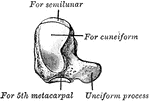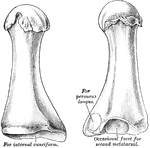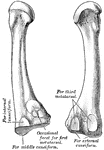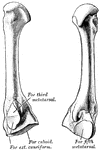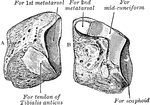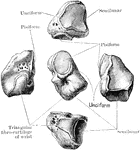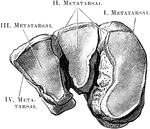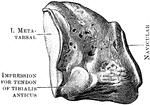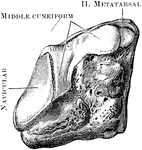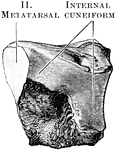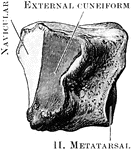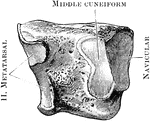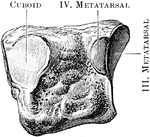Search for "Cuneiform"
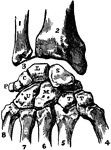
Bones of the Carpus
Articulations of bones of the carpus (wrist area). Labels: 1, ulna; 2, radius; 3, inter-articular fibro-cartilage;…

Upper Surface of the Left Foot
Bones of the upper surface of the left foot. Labels: 1, astragalus; 2, its anterior face; 3, os calcis;…

Bones of the Foot
The bones of the foot. Labels: Ca, calcaneum, or os calcis; Ta, articular surface for tibia on the astragalus;…

Bones of the Foot
The upper surface of the bones of the foot. Labels: 1, the surface of the astragulus or ankle bones,…

Oblique Anteroposterior Section of
Oblique anteroposterior section of foot, to show the synovial cavities of the tarsus. Labels: 1, tibia;…

Lisfranc's Amputation at the Tarsometatarsal Joint
Lifrac's operation consists in amputation through the tarsometatarsal line of joints. Labels: a, b,…

Foot Bones
"The foot. a, calcaneum; b, astragalus; c, cuboid; d, metatarsal, of which there are five; e, phalanges,…

Cuneiform Bone
The cuneiform may be distinguished by its pyramidal shape, and by its having an oval, isolated facet…

Cavity of Larynx
Cavity of larynx, as seen by means of the laryngoscope. A, the rima glottidis closed. B, the rima glottidis…

Bear Foot
"Palmar aspect of left fore foot of a black bear (Ursus americanus). scl, scapholunar; c, cuneiform;…
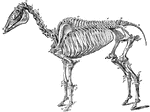
Skeleton of a Horse
The skeleton of a horse. Axial Skeleton. The Skull. Cranial Bones: a, occipital, 1; b, wormian, 1; c,…

Carpus of a Horse
Front aspect of the right carpus of a horse. Labels: 1, cuneiform; 2, lunar; 3, scaphoid; 4, trapezium;…
Horse Leg
External view of bones of right carpus, metacarpus, and digit of a horse. 1, distal end of radius; 2,…
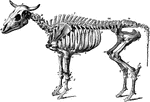
Ox Skeleton
The skeleton of an ox. Axial Skeleton. The skull. Cranial Bones- occipital, 1: b, parietal, 2; a, frontal,…

Skeleton of a Hog
Skeleton of the hog. Axial skeleton. The skull. Cranial bones- a, occipital, 1; b, parietal, 2; d, frontal,…
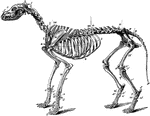
Skeleton of a Dog
The skeleton of the dog. Axial skeleton. The skull. Cranial bones- a, occipital, 1; b, parietal, 2;…
Horse Leg Muscles
Anterior tibial group of muscles of the right limb, seen from before and the outside. Labels: a, flexor…

Bones of Human Foot
"Bones of Human Foot, or Pes, the third principal segment of the hind limb, consisting of tarsus, metatarsus,…

The Wing Bones of a Young Grouse
"Fig. 29., from a young grouse (Centrocercus urophasianus, six months old), is designed to show the…

Beginning of Written Language
"Below the pictured hieroglyphics in the first line is the same text in a simpler writing known as hieratic.…
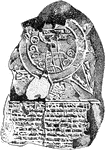
A Babylonian Map of the World
"A tablet of dark brown clay, much injured, dating from the 8th or 7th century B.C. The two large concentric…


